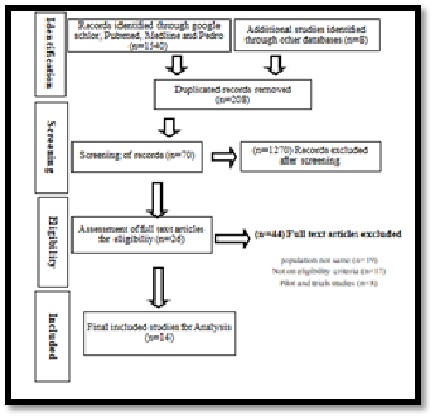Narrative Review of Factors Affecting Lower Back Pain among Workers in Pakistan
Abstract
 Abstract Views: 119
Abstract Views: 119
According to the world health organization (WHO), lower back pain (LBP) is the most common health
hazard among workers and is among the top ten health hazards around the globe. The Global Burden of
Disease (GBD) 2010 stated LBP as amongst the top 6 diseases which cause disability injuries and other
chronic diseases. This is the impairment that poses the most economic burden on society as a whole,
including individuals, businesses, and the government. This study aims to find out the factors that affect
lower back pain among workers associated with different professions in Pakistan. Data were collected
from different databases, such as PubMed, Google scholar, and PEDro by using a predefined search
strategy with proper Boolean terms ‘AND’ or ‘OR’ or ‘NOT’. The data were collected from the
literature available for past 10 years. Additionally, articles with relevant material and titles were
reviewed for conducting the current research review. The most common risk factors that were seen
almost among all professions were static position and prolonged working hours, any work that demands
prolonged standing or sitting, bending or twisting, and improper lifting. Several professional workers are
at high risk for developing LBP but among all the professions physiotherapists, sonographers, bankers,
and shopkeepers were at higher verge for developing LBP. It was found that the prevalence of LBP is
increasing day by day and significantly affecting workers in every profession. Therefore, timely
trainings with proper ergonomic techniques could decrease LBP and increase economic productivity in
Pakistan. It can be said that good ergonomics for good economics.
Downloads
References
Bansal D, Asrar MM, Ghai B, Pushpendra D. Prevalence and Impact of Low Back Pain in a Community-Based Population in Northern India. Pain Physician. 2020;23(4):E389-E398.
Çınar-Medeni Ö, Elbasan B, Duzgun I. Low back pain prevalence in healthcare professionals and identification of factors affecting low back pain. J Back Musculoskelet Rehabil. 2017;30(3):451-459.
Schneider S, Lipinski S, Schiltenwolf M. Occupations associated with a high risk of self-reported back pain: representative outcomes of a back pain prevalence study in the Federal Republic of Germany. Eur Spine J. 2006;15(6):821-833. https://doi.org/10.1007/s00586-005-1015-2
Buchbinder R, van Tulder M, Öberg B, et al. Low back pain: a call for action. The Lancet. 2018;391(10137):2384-2388. https://doi.org/10.1016/S0140-6736(18)30488-4
Urits I, Burshtein A, Sharma M, et al. Low back pain, a comprehensive review: pathophysiology, diagnosis, and treatment. Curr Pain Headache Rep. 2019;23(3):23. https://doi.org/10.1007/s11916-019-0757-1
Allegri M, Montella S, Salici F, et al. Mechanisms of low back pain: A guide for diagnosis and therapy. F1000Research. 2016;5:F1000 Faculty Rev-1530 https://doi.org/10.12688/f1000research.8105.2
Mohseni-Bandpei MA, Fakhri M, Bargheri-Nesami M, Ahmad-Shirvani M, Khalilian AR, Shayesteh-Azar M. Occupational back pain in Iranian nurses: an epidemiological study. Br J Nurs. 2006;15(17):914-917. https://doi.org/10.12968/bjon.2006.15.17.21904
Lee K, Farhanah B, Rifaaie M, Chang C, Hassan S, Azuhairi A. Prevalence of low back pain and its associated factors among doctors in a hospital in Selangor. Int J Med Sci Public Health. 2014;1(1):189-197.
Grabska E, Brzęk A, Knapik A, et al. The occurrence of back pain in young paramedics. 2016;70:291-297. https://doi.org/10.18794/aams/67646
Meucci RD, Fassa AG, Faria NMX. Prevalence of chronic low back pain: systematic review. Rev Saude Publica. 2015;49:73. https://doi.org/10.1590/S0034-8910.2015049005874
Abdel-Salam DM, Almuhaisen AS, Alsubiti RA, et al. Musculoskeletal pain and its correlates among secondary school female teachers in Aljouf region, Saudi Arabia. J Public Health. 2019;29:303-310. https://doi.org/10.1007/s10389-019-01127-8
Wáng YXJ, Wu A-M, Santiago FR, Nogueira-Barbosa MH. Informed appropriate imaging for low back pain management: A narrative review. J Orthop Translat. 2018;15:21-34. https://doi.org/10.1016/j.jot.2018.07.009
Kim J-Y, Shin J-S, Lim M-S, et al. Relationship between simultaneous exposure to ergonomic risk factors and work-related lower back pain: a cross-sectional study based on the fourth Korean working conditions survey. Ann Occup Environ Med. 2018;30(1):58. http://doi.org/10.1186/s40557-018-0269-1
Shiri R, Coggon D, Falah-Hassani K. Exercise for the prevention of low back pain: systematic review and meta-analysis of controlled trials. Am J Epidemiol. 2018;187(5):1093-1101. https://doi.org/10.1093/aje/kwx337
Stankov L. Conservative syndrome: Individual and cross-cultural differences. J Cross Cult Psychol. 2017;48(6):950-960. https://doi.org/10.1177/0022022117709984
Khan MNU, Morrison NM, Marshall PW. The Role of Fear-avoidance beliefs on low back pain-related disability in a developing socioeconomic and conservative culture: A cross-sectional study of a Pakistani population. J Pain Res. 2020;13:2377. https://doi.org/10.2147/JPR.S258314
Murray CJ, Lopez AD. Measuring global health: motivation and evolution of the Global Burden of Disease Study. The Lancet. 2017;390(10100):1460-1464. https://doi.org/10.1016/S0140-6736(17)32367-X
Hurwitz EL, Randhawa K, Torres P, et al. The Global Spine Care Initiative: a systematic review of individual and community-based burden of spinal disorders in rural populations in low-and middle-income communities. Eur Spine J. 2018;27(6):802-815. https://doi.org/10.1007/s00586-017-5393-z
Hartvigsen J, Hancock MJ, Kongsted A, et al. What low back pain is and why we need to pay attention. The Lancet. 2018;391(10137):2356-2367.
Arslan SA, Hadian MR, Olyaei G, et al. Prevalence and risk factors of low back pain among the office workers of King Edward Medical University Lahore, Pakistan. Physic Treatment-Speci Physic Ther J. 2016;6(3):161-168. https://doi.org/10.18869/nrip.ptj.6.3.161
Arooj A, Amjad F, Zulfiqar F, Tauqeer S, Khalid K, Ahmad A. Factors affecting musculoskeletal low back pain due to computer usage. Rawal Med J. 2022;47(1):217-217.
Arooj A, Ahmed A, Yazdani MS, Gilani SA, Hanif K, Tanveer F. Prevalence of musculoskeletal loe back pain in office workers at Lahore, Pakistan. Pak Arm Force Med J. 2018;68(4):919-23.
Ghilan K, Al-Taiar A, Al Yousfi N, Al Zubaidi R, Awadh I, Al-Obeyed Z. Low back pain among female nurses in Yemen. Int J Occup Med Environ Health. 2013;26(4):605-614. https://doi.org/10.2478/s13382-013-0124-0
Oksuz E. Prevalence, risk factors, and preference-based health states of low back pain in a Turkish population. Spine. 2006;31(25):E968-E972. https://doi.org/10.1097/01.brs.0000247787.25382.3c
Hoy D, Bain C, Williams G, et al. A systematic review of the global prevalence of low back pain. Arthritis Rheum. 20/12;64(6):2028-2037. https://doi.org/10.1002/art.34347
Abdulrazzaq MM. Backache among different specialties in dentistry (An over world survey). Medico-legal Update. 2020;20(4):4757.
Rathore FA, Attique R, Asmaa Y. Prevalence and perceptions of musculoskeletal disorders among hospital nurses in Pakistan: A cross-sectional survey. Cureus. 2017;9(1):e1001. https://doi.org/10.7759/cureus.1001
Zahid H, Khalid F, Ahmed U, Ahmed A, Gillani SA, Hanif MK. Frequency of low back pain among school teachers of Lahore, Pakistan. Int J Sci Eng Res. 2017;8(12):1776-1782.
Waqas M, Ghaffar T, Javed H, Siddique S, Javed A. Study to Find Out the Frequency of Low Back Pain and Its Associated Factors among Boys College Teachers of Twin Cities (Rawalpindi and Islamabad), Pakistan. Physiother Rehabil. 2017;2(130):2573-0312. https://doi.org/10.4172/2573-0312.1000130
Junejo MA, Tahir SM, Behan RB. Prevalence and risk factors for work related musculoskeletal disorders among sonographer of Sindh Province Pakistan. J Liaquat Uni Med Health Sci. 2017;16(01):29-36. https://doi.org/10.22442/jlumhs.171610502
Tanzil S, Jamali T, Inam S, Abbas A. Frequency and severity of low back pain among healthcare providers and associated factors in a tertiary care, public hospital in Karachi. Occup Med Health Aff. 2019;7(1):1000285.
Shah SZA, Jan MBA, Rahman MU, Khan DA. Prevalence of work-related low back pain among clinical physical therapists in Pakistan. Ann Occup Environ Med. 2016;2(1):19-22.
Mahmood T, Asghar M, Maqsood U, Mahmood W. Frequency of Low back pain among the barbers of Lahore, Pakistan. Rawal Med J. 2018;43(3):491-493.
Adam V, Awunor N. Perceptions and factors affecting utilization of health services in a rural community in Southern Nigeria. J Med Biomed Res. 2014;13(2):117-124.
Hussain T, Taufiq F, ul Hassan T. Prevalence and risk factors for low back pain among shopkeepers/salesman at model town link road Lahore, Pakistan. Rawal Med J. 2017;42(2):162-164.
Fiaz MW, Ahmad A, Munawar A, Rabia K, Fatima M. Prevalence of musculoskeletal pain in traffic police wardens of Lahore, Pakistan. Rawal Med J. 2018;43(1):61-63.
Wami SD, Abere G, Dessie A, Getachew D. Work-related risk factors and the prevalence of low back pain among low wage workers: results from a cross-sectional study. BMC Public Health. 2019;19(1):1072. https://doi.org/10.1186/s12889-019-7430-9
Sadia H, Munawar A, Tanveer F, Ahmed A, Gilani SA. Frequency of low back and neck pain among female drivers. Rawal Med J. 2019;44(2):365-367.
Aslam MW, Tanveer F, Arshad HS. Job-related musculoskeletal disorders in bus drivers of Lahore, Pakistan. Int J Sci Res. 2016;5(5):796-800.
Ijaz M, Akram M, Ahmad SR, Mirza K, Ali Nadeem F, Thygerson SM. Risk Factors Associated with the Prevalence of Upper and Lower Back Pain in Male Underground Coal Miners in Punjab, Pakistan. Int J Environ Res Public Health. 2020;17(11):4102.
Tauqeer S, Amjad F, Ahmed A, Gillani SA. Prevalence of low back pain among bankers of Lahore, Pakistan. Khy Med Uni J. 2018;10(2):111-114.
Umar T, Egbu C, Honnurvali MS, Saidani M, Al-Mutairi M. An assessment of health profile and body pain among construction workers. Munic Eng. 2020:173(3):125-135. https://doi.org/10.1680/jmuen.18.00019
Rasheed H, Rashid J, Javeed RS. Frequency of low back pain among nurses working in Jinnah hospital Lahore. Int J End Health Sci Res. 2017;5(3):44-51.
Mekonnen TH, Yenealem DG. Factors affecting healthcare utilization for low back pain among nurses in Gondar town, northwest Ethiopia, 2018: A cross-sectional study. BMC Res Notes. 2019;12(1):185. https://doi.org/10.1186/s13104-019-4231-2
Kanyenyeri L, Asiimwe B, Mochama M, Nyiligira J, Habtu M. Prevalence of back pain and associated factors among bank staff in selected banks in Kigali, Rwanda: A cross sectional study. Health Sci J. 2017;11(3):1-7. https://doi.org/10.21767/1791-809X.1000505
AL-Rammah TY, Aloufi AS, Algaeed SK, Alogail NS. The prevalence of work-related musculoskeletal disorders among sonographers. Work. 2017;57(2):211-219. https://doi.org/10.3233/WOR-172558
Barros-Gomes S, Orme N, Nhola LF, et al. Characteristics and consequences of work-related musculoskeletal pain among cardiac sonographers compared with peer employees: a multisite cross-sectional study. J Am Soc Echocardiogr. 2019;32(9):1138-1146. https://doi.org/10.1016/j.echo.2019.04.416
Woodman A, Homan M, Niaz A, Al-Jamea L, Akhtar M, Sager M. Low back pain among healthcare personnel in Saudi Arabia: A systematic review. Ibnosina J M Bio Sci. 2020;12(2):108-117. https://doi.org/10.4103/ijmbs.ijmbs_56_20
Kashif M, Darain H, Sharif F, Jamil M, Majeed S, Ullah I. Association between low back pain and prolonged standing in university teachers. Ann Allied Health Sci. 2017;3(1):8-13.
Eggers L. Prevalence and selected risk factors for neck, shoulder and low back pain among primary school teachers in the Central Durban area: a cross-sectional study. Dissertation. Durban University of Technology; 2016. https://doi.org/10.51415/10321/1773
Campos-Fumero A, Delclos GL, Douphrate DI, et al. Low back pain among office workers in three Spanish-speaking countries: findings from the CUPID study. Inj Prev. 2017;23(3):158-164. http://dx.doi.org/10.1136/injuryprev-2016-042091
Mondal R, Sarker RC, Akter S, Banik PC, Baroi SK. Prevalence of low back pain and its associated factors among physiotherapists in Dhaka city of Bangladesh in 2016. J Occup Health Epidemiol. 2018;7(2):70-74. http://dx.doi.org/10.29252/johe.7.2.70
Cho T-S, Jeon W-J, Lee J-G, Seok J-M, Cho J-H. Factors affecting the musculoskeletal symptoms of korean police officers. J Phys Ther Sci. 2014;26(6):925-930. https://doi.org/10.1589/jpts.26.925
Peterson CL, Evans KD, Axiotis IR. Sonographer scanning practices and musculoskeletal injury: evaluation of an occupational health issue using the health belief model. J Diagn Med Sonogr. 2017;33(5):412-418. https://doi.org/10.1177/8756479317727460

Copyright (c) 2022 Ayesha Arooj, Aamir Aziz, Fariha Khalid, M. Hussain Iqbal

This work is licensed under a Creative Commons Attribution 4.0 International License.
BSR follows an open-access publishing policy and full text of all published articles is available free, immediately upon publication of an issue. The journal’s contents are published and distributed under the terms of the Creative Commons Attribution 4.0 International (CC-BY 4.0) license. Thus, the work submitted to the journal implies that it is original, unpublished work of the authors (neither published previously nor accepted/under consideration for publication elsewhere). On acceptance of a manuscript for publication, a corresponding author on the behalf of all co-authors of the manuscript will sign and submit a completed the Copyright and Author Consent Form.









